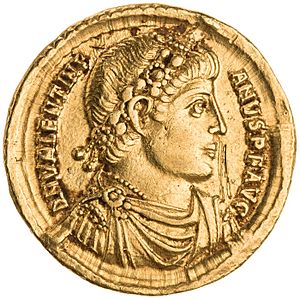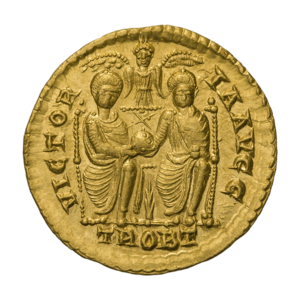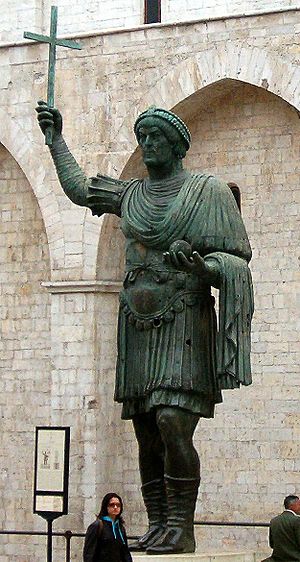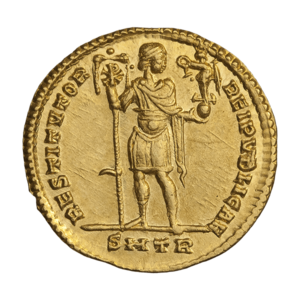Valentinian I facts for kids
Quick facts for kids Valentinian I |
|||||
|---|---|---|---|---|---|

Solidus of Valentinian marked: d·n· valentinianus p·f· aug·
|
|||||
| Roman emperor (in the West) | |||||
| Reign | 26 February 364 – 17 November 375 | ||||
| Predecessor | Jovian | ||||
| Successor | Gratian and Valentinian II | ||||
| Co-emperor | Valens (in the East) | ||||
| Born | 321 Cibalae, Pannonia, Roman Empire (now Vinkovci, Croatia) |
||||
| Died | 17 November 375 (aged 54) Brigetio, Pannonia Valeria (now Szőny, Hungary) |
||||
| Spouse | Marina Severa Justina |
||||
| Issue |
|
||||
|
|||||
| Dynasty | Valentinianic | ||||
| Father | Gratianus Funarius | ||||
| Religion | Nicene Christianity | ||||
Valentinian I (Latin: Valentinianus; 321 – 17 November 375), also known as Valentinian the Great, was a powerful Roman emperor. He ruled alongside his brother Valens from 364 to 375. During his time as emperor, Valentinian successfully fought against several groups like the Alamanni, Quadi, and Sarmatians. He made the Roman borders stronger and led military campaigns across the Rhine and Danube rivers.
His skilled general, Theodosius, put down a rebellion in Africa. Theodosius also stopped a big attack on Roman Britain by the Picts, Scoti, and Saxons. Valentinian started the Valentinianic dynasty. His sons, Gratian and Valentinian II, took over ruling the western part of the Roman Empire after him.
Contents
Early Life and Family
Valentinian was born in 321 in a place called Cibalae. This area is now Vinkovci, Croatia. His family was from Illyria. Valentinian and his younger brother Valens were the sons of Gratianus. Their father was a military officer famous for his wrestling skills.
Gratianus became a high-ranking officer in Africa in the late 320s or early 330s. Young Valentinian went with his father to Africa. However, Gratianus was later accused of misusing money and had to retire. Valentinian joined the army in the late 330s. He likely became a protector domesticus, a type of bodyguard.
In 350, Constans I was killed by agents of Magnentius. Magnentius was a commander who declared himself emperor in Gaul. Constantius II, Constans' older brother, was emperor in the East. He quickly marched towards Magnentius with a large army. The two emperors fought in the Battle of Mursa Major in Pannonia. Constantius won, but it was a very costly victory.
Around this time, Constantius took away Gratianus' property. This was because Gratianus had supposedly welcomed Magnentius when he was in Pannonia. Despite his father's troubles, Valentinian seemed unaffected. It is not clear if he fought for Magnentius.
Serving Under Emperors
The conflict between Magnentius and Constantius caused problems. The Alamanni and Franks took advantage of the confusion. They crossed the Rhine river and attacked Roman towns. In 355, Constantius made his cousin Julian a Caesar. This meant Julian was a junior emperor.
Julian was put in charge of one of the main armies in Gaul. Constantius planned for Julian and another general, Barbatio, to attack the Alamanni together. However, some Alamanni slipped past them and attacked Lugdunum (Lyon). Julian sent Valentinian and another officer to watch the road. But their efforts were hindered by Barbatio. The Alamanni king Chnodomarius then attacked the Romans, causing many losses. Barbatio blamed Valentinian, and Valentinian was removed from the army.
With his military career seemingly over, Valentinian went to his family estate. Two years later, his first son Gratian was born. Gratian's mother was Valentinian's wife, Marina Severa. Valentinian's activities during this time are unclear. Some say he was exiled because he reacted angrily at a pagan temple. He reportedly said, "I am not purified, but defiled," and struck a priest.
Later, Valentinian returned to military service. He served in different roles and locations. Under Emperor Jovian, he was promoted to lead an elite infantry regiment. He was then sent to Ancyra.
Becoming Emperor
When Emperor Julian died during a campaign, the army quickly chose a new leader. They picked Jovian as emperor. Jovian's rule was short, lasting only eight months. He died suddenly while traveling. His death was thought to be from poisoning or accidental carbon monoxide poisoning. Jovian is remembered for bringing back Christianity as the favored religion.
The army gathered in Nicaea to choose a new emperor. They offered the position to Salutius, who refused. After considering other names, they finally agreed on Valentinian. He was well-qualified and nearby. Messengers were sent to tell him in Ancyra.
Valentinian's Reign
Valentinian accepted the role of emperor on February 25 or 26, 364. As he prepared to speak, soldiers threatened to riot. They were unsure where his loyalty lay. Valentinian assured them that the army was his top priority. The soldiers were impressed by his confidence. To prevent future problems, he agreed to choose a co-emperor. This would also reassure officials in the Eastern Empire.
Valentinian chose his brother Valens as co-emperor. This happened in Constantinople on March 28, 364. Valens was clearly under his brother's authority. The rest of 364 was spent dividing up duties and military commands. Valentinian took control of Italy, Gaul, and Illyricum. Valens governed the Eastern part of the empire from Constantinople. Valentinian's court was in Milan (Mediolanum).
Protecting Gaul and Germania
In 365, the Alamanni crossed the Rhine and attacked Gaul. At the same time, a revolt began against Valens in the East. Valentinian first planned to help Valens. But after advice from his court and pleas from Gallic cities, he decided to stay and protect Gaul.
Valentinian sent two generals against the Alamanni, but they were defeated and killed. In 366, another general, Dagalaifus, was also unsuccessful. Later that year, Jovinus took over. He won several battles and pushed the Alamanni out of Gaul. He was rewarded for his efforts.
In 367, Valentinian was busy with problems in Britain and northern Gaul. The Alamanni took advantage and attacked again. Valentinian managed to arrange the killing of an Alamannic leader. But he wanted to bring the Alamanni fully under Roman control. He spent the winter of 367 gathering a huge army.
In the spring of 368, Valentinian, his eight-year-old son Gratian, and the army crossed the Rhine. They entered Alamannic lands. They burned homes and food stores. Finally, Valentinian fought the Alamanni in the Battle of Solicinium. The Romans won but lost many soldiers. A temporary peace was made, and Valentinian returned to Trier. In 369, Valentinian ordered new defenses built along the Rhine. He even built a fortress across the Rhine near modern Heidelberg. The Alamanni protested, but their complaints were ignored. They attacked and destroyed the fortress while it was still being built.
In 370, the Saxons attacked northern Gaul again. Roman generals fought them and achieved some success. A truce was called, and the Saxons gave young men to the Roman army. In return, they were allowed to go home. But the Romans ambushed them and destroyed the entire Saxon force.
Valentinian tried to get the Burgundians to attack the Alamanni. The Burgundians were enemies of the Alamanni. But talks with the Burgundians failed because Valentinian refused to meet their envoys. Still, rumors of a Roman alliance with the Burgundians scared the Alamanni. This allowed the general Theodosius to attack the Alamanni. Many Alamannic prisoners were taken. They were settled in Italy.
Valentinian continued to fight the Alamanni for four more years. However, problems in Africa and on the Danube river made it difficult. In 374, Valentinian had to make peace with the Alamanni. He was needed to stop an invasion by the Quadi and Sarmatians.
The Great Conspiracy in Britain
In 367, Valentinian received bad news from Britain. A combined force of Picts, Attacotti, and Scots had killed Roman commanders. At the same time, Frankish and Saxon forces were raiding northern Gaul. The Roman Empire was facing a big crisis and risked losing control of Britain.
Valentinian sent his general, Theodosius, to Britain. Theodosius arrived in 368 with several legions. He landed at Rutupiæ and went to Londinium (London). He restored order in southern Britain. He also gathered the remaining Roman soldiers in Britain. These units had lost their organization after their commanders were defeated.
In 369, Theodosius began to take back the areas north of London. He put down a local revolt. Theodosius then restored the rest of Britain to the empire. He rebuilt many forts and renamed northern Britain 'Valentia'. After his success, Valentinian promoted Theodosius to a higher military command.
Troubles in Africa and on the Danube
In 372, a rebellion started in the African provinces. This rebellion was caused by a corrupt Roman official named Romanus. Romanus was involved in disputes among local leaders. People were also angry because Romanus misused public money. He also failed to protect the province from desert nomads. Valentinian sent Theodosius to fix the situation. Over two years, Theodosius uncovered Romanus' crimes and defeated the rebellion.
In 373, fighting broke out with the Quadi. These were Germanic-speaking people living near the Danube river. Like the Alamanni, the Quadi were angry that Valentinian was building forts in their territory. They complained, but their king, Gabinius, was killed during peace talks. This made the Quadi and their allies, the Sarmatians, go to war. They crossed the Danube and attacked the province of Pannonia Valeria. They damaged the countryside. Two Roman legions were defeated by the Sarmatians.
Valentinian heard about these problems in late 374. The next spring, he left Trier and arrived at Carnuntum. Sarmatian envoys asked for forgiveness. Valentinian said he would investigate. He decided to punish the Quadi. He spent the summer preparing for a campaign. In the fall, he crossed the Danube into Quadi territory. He pillaged their lands without opposition. He then went to Savaria for the winter.
Death of Valentinian
Valentinian decided to continue his campaign without waiting for spring. He moved from Savaria to Brigetio. On November 17, he met with a group of Quadi. They offered to provide new soldiers for the Roman army in exchange for peace. However, during the meeting, they insisted that the conflict was caused by Roman forts. They also said that some Quadi groups might not follow treaties made by their chiefs. This made Valentinian very angry. While yelling at the envoys, he suffered a fatal stroke on November 17, 375. As was the custom, he was later honored as a god, known as Latin: Divus Valentinianus Senior, lit. 'the Divine Valentinian the Elder'.
Valentinian's Legacy
Historians describe Valentinian I as a strong leader. He was known for being very strict. He was a military commander, not a scholar. However, he appointed Ausonius, a brilliant Latin scholar, to teach his son Gratian. This shows he valued education.
Valentinian was a capable soldier and a careful administrator. He cared about the well-being of ordinary people. He founded schools and provided doctors for the poor in Rome. He appointed a physician for each of the city's fourteen districts.
Valentinian was a Christian. He allowed religious freedom for all his subjects. He only banned certain rituals and magic. He also tried to stop the Christian clergy from becoming too wealthy. He issued rules about gifts to Christian clergy and made them pay public duties.
There is a story about Valentinian's marriages. Some sources suggest he had two wives at once. However, Roman law allowed for divorce. Since Christians did not recognize divorce at the time, some historians described him as a bigamist. Other accounts suggest his first wife was banished for an illegal action before he married his second wife.
See also
 In Spanish: Valentiniano I para niños
In Spanish: Valentiniano I para niños
- List of Roman emperors
- Illyrian emperors
Sources
Primary sources
- Ammianus Marcellinus. Rerum gestarum libri qui supersunt. W. Seyfarth, ed. 3 vols. Leipzig, 1978.
- Consularia Constantinopolitana. T. Mommsen ed., Monumenta Germaniae Historica, Auctores Antiquissimi. Volume 9. Berlin, 1892.
- Codex Theodosianus. T. Mommsen, P.M. Meyer, and P. Krüger, eds. Theodosiani libri XVI cum constitutionibus Sirmondianis et leges novellae ad Theodosianum pertinentes (2 vols.). Berlin, 1905.
- Corpus Inscriptionum Latinarum. Vol. 6. T. Mommsen, ed. Berlin, 1875.
- Epitome de Caesaribus. F.R. Pichlmayr, ed. Leipzig, 1961.
- Jerome. Chronicon. R. Helm, ed., in Malcolm Drew Donalson, A Translation of Jerome's Chronicon with Historical Commentary. Lewiston, NY, 1996.
- Orosius. Adversus paganos historiarum libri septem. Z. Zangemeister, ed. Corpus scriptorum ecclesiasticorum latinorum 5. Vienna, 1882.
- Socrates. Historia Ecclesiastica. J.P. Migne ed., Patrologia Graeca 67. Paris, 1864.
- Sozomen. Historia Ecclesiastica. J.P. Migne ed., Patrologia Graeca 67. Paris, 1864.
- Theoderet. Historia Ecclesiastica. J.P. Migne ed., Patrologia Graeca 82. Paris, 1864.
- Zosimus. Historia nova. François Paschoud, ed. and trans., Zosime: Histoire Nouvelle (3 vols.). Paris, 1971–89.
- Ammian, Books 26‑30 Uchicago.edu. English summaries. Main text in Latin.
Secondary accounts
- Edward Gibbon, The Decline and Fall of the Roman Empire, 1776.
- Schmidt-Hofner, Sebastian. Reagieren und Gestalten: der Regierungsstil des spaetroemischen Kaisers am Beispiel der Gesetzgebung Valentinians I. Muenchen: Beck, 2008. 398 p. (Vestigia, Bd. 58).
- Ernst Stein, Histoire du Bas-Empire, vol. i, chap. 4 (1959).







